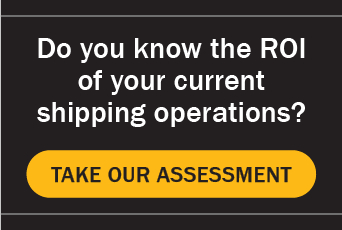Are You Shipping Dangerous or Hazmat Goods and Don’t Know It?
B2B and B2C companies of all sizes have found a powerful and transformative sales channel in the eCommerce marketplace.
Online selling has made it much easier to reach a massive global customer base, which, according to Statista, is currently at 2.14 billion digital buyers and growing.

Many companies have further boosted online sales revenues by adding new products to attract and retain satisfied customers.
It’s a great strategy, with one significant caveat – do you know if any of your new products are considered hazardous materials? What are the risks of overlooking this question when handling, labeling and shipping products?
What is the Definition of a Dangerous Good or Hazardous Material?
Many people think that the definition of dangerous goods (DG) or hazardous material (hazmat) applies to explosives, gasoline, ammunition, chlorine, acids, etc.
 However, this is not the case at all. Many commonly purchased consumer products fall into a dangerous goods category, such as aerosol sprays, nail polish, cosmetics, alcohol, paints, medicines, batteries, dry ice, and even the contents of first aid kits (some).
However, this is not the case at all. Many commonly purchased consumer products fall into a dangerous goods category, such as aerosol sprays, nail polish, cosmetics, alcohol, paints, medicines, batteries, dry ice, and even the contents of first aid kits (some).
According to the Federal Aviation Administration (FAA), a dangerous good (also known as hazardous material or hazmat) is any substance or material capable of posing an unreasonable risk to health, safety, and property when transported in commerce.
Incorrect packaging and improper handling of hazardous materials can be dangerous – even deadly – not to mention costly. Failure to comply with hazmat shipping regulations results in significant fines for the individual and organization that prepared the shipment.
The High Cost of Hazmat Fines
Hazmat fines were most recently increased on May 3, 2021, and are now assessed at the following rates:
- Maximum hazmat civil penalty for hazmat shipping violations – $84,425/day per violation.
- A violation that results in death, serious illness, severe injury, or substantial property damage – $196,992/day per violation.
- Minimum penalty for failure to provide hazmat training for employees – $508 per employee per day.
(Source: University of California Institute of Hazardous Materials Management)
Amazon, for example, paid a $91,000 fine in 2014 for improperly shipping a flammable liquid adhesive that was classified as a hazardous good by the Dept. of Transportation (DOT). The FAA noted that Amazon was fined after employees “offered the shipment without the requisite shipping papers or emergency response information, and did not mark, label, or properly package the shipment.” The DOT can also fine a company for not providing proper hazardous material training to its employees.
Do your new products require lithium-ion or lithium metal batteries? Thousands of commonly purchased battery-powered consumer products such as toys, cell phones, tools, vape pens, and computer laptops that are often delivered by small parcel carriers are also subject to hazardous material regulations. If your company has recently added such products, it is wise to revisit your receiving and shipping operations to ensure compliance.
Steps to Avoid Hazardous Material Shipping Risks and Fines
Any company expanding its product line needs to establish procedures to evaluate and identify whether the new products are classified as hazardous. While identification is the first step, you will need to put systems in place to ensure that you can meet the safety regulations to keep your employees safe and avoid DOT fines.
Hazmat Training and Certification for Shipping Staff
The best way to ensure compliance with all relevant hazmat shipping regulations is to provide Hazmat training and certification classes for all shipping and warehouse management staff.
These courses typically begin with a general DOT Safety and Security Awareness module and additional method/material-specific training classes. For example, employees working with:
- Air shipments will require IATA certification
- Ocean shipments will require IMDG certification
- Ground shipments must be certified in DOT 49 CFR (highway) regulations.
Certified shippers sign off on every shipment, indicating their pledge that the packages contain the materials described in the related documentation. The signature indicates that items are packaged according to safety requirements, and appropriate labels are affixed to the shipment. By signing, shippers take personal responsibility for the shipment, which means they can be personally liable for any fines assessed due to errors.
Note that carriers such as UPS and FedEx do not permit the shipment of hazardous materials without prior authorization. These shipments must be discussed in advance and included in shipping contracts before carriers agree to handle them. Safety is a top priority for these businesses, and they will insist that individuals who are preparing the packages are fully trained and certified.
Shipping Hazmat Safely
Training and certification programs are the best solutions to ensure that dangerous goods are transported safely. Through appropriate training, shippers gain a clear understanding of which materials are permitted on passenger aircraft, which must be transported on cargo aircraft, and which are not approved to fly at all. Failure to observe safety regulations can cause serious injury – even death – making appropriate instruction a must.
Ensure Accuracy with Integrated Hazmat and Shipping Software
Beyond developing a hazmat training and compliance program in your operations, it is also critical to adopt processes that prevent labeling and shipping errors. After all, there are far too many types of hazmat to risk improvisation.
Businesses that rely on tribal knowledge and manual processes quickly discover how easy it is to make a mistake – and how difficult it is to regain the trust of suppliers and clients when fines and injuries are involved.
One best practice is to automate your hazmat classifying and labeling process with your shipping system. CLS offers an integrated solution with its InfoShip®/Vx multi-carrier shipping software solution and Labelmaster Dangerous Goods Information System (DGIS) to ensure proper hazmat labels are automatically produced and applied to every shipment as part of the label printing process.
You’ll gain the benefit of enhancing your shipping operations to achieve total accuracy, hazmat compliance, and fast, automated shipment processing.
Learn More
If you have questions about dangerous goods requirements and evaluating your shipping processes, please feel free to contact us today.
 Greg Marone is a shipping expert with decades of experience in warehouse management operations and technology. CLS has worked with many companies to improve shipping processes and reduce shipping costs with multi-carrier shipping software, integrated pack/ship stations, data collection solutions, and more. CLS shipping software is also connected to a wide variety of domestic and international carriers. Contact us for a complimentary consultation.
Greg Marone is a shipping expert with decades of experience in warehouse management operations and technology. CLS has worked with many companies to improve shipping processes and reduce shipping costs with multi-carrier shipping software, integrated pack/ship stations, data collection solutions, and more. CLS shipping software is also connected to a wide variety of domestic and international carriers. Contact us for a complimentary consultation.
Sources:
What Are Dangerous Goods? – Federal Aviation Administration
How Many People Shop Online in 2021? – Oberlon
Ten Ecommerce Statistics You Need to Know in 2021 – webinterpret.com
Topics: hazmat shipping,multi-carrier shipping software,small parcel,





